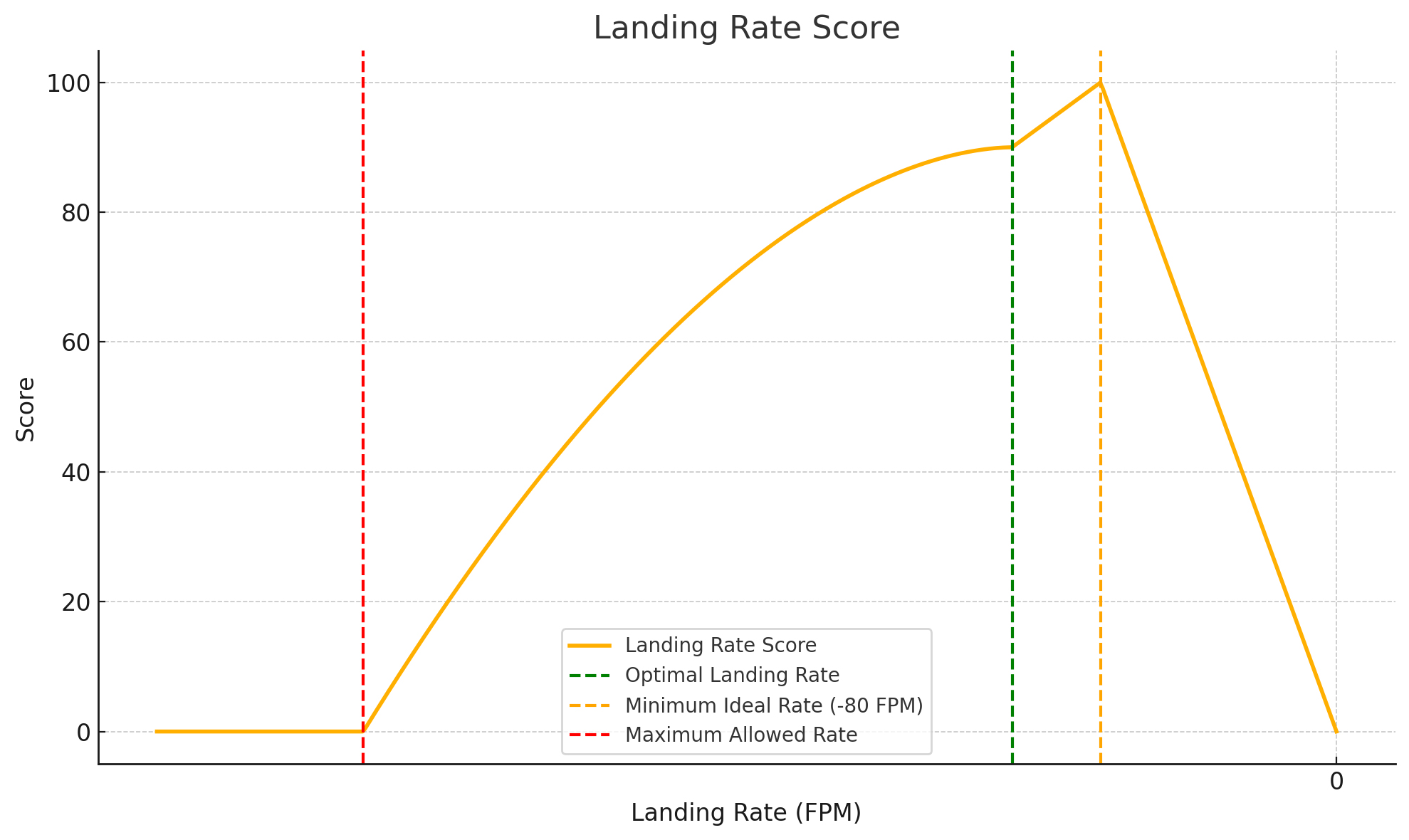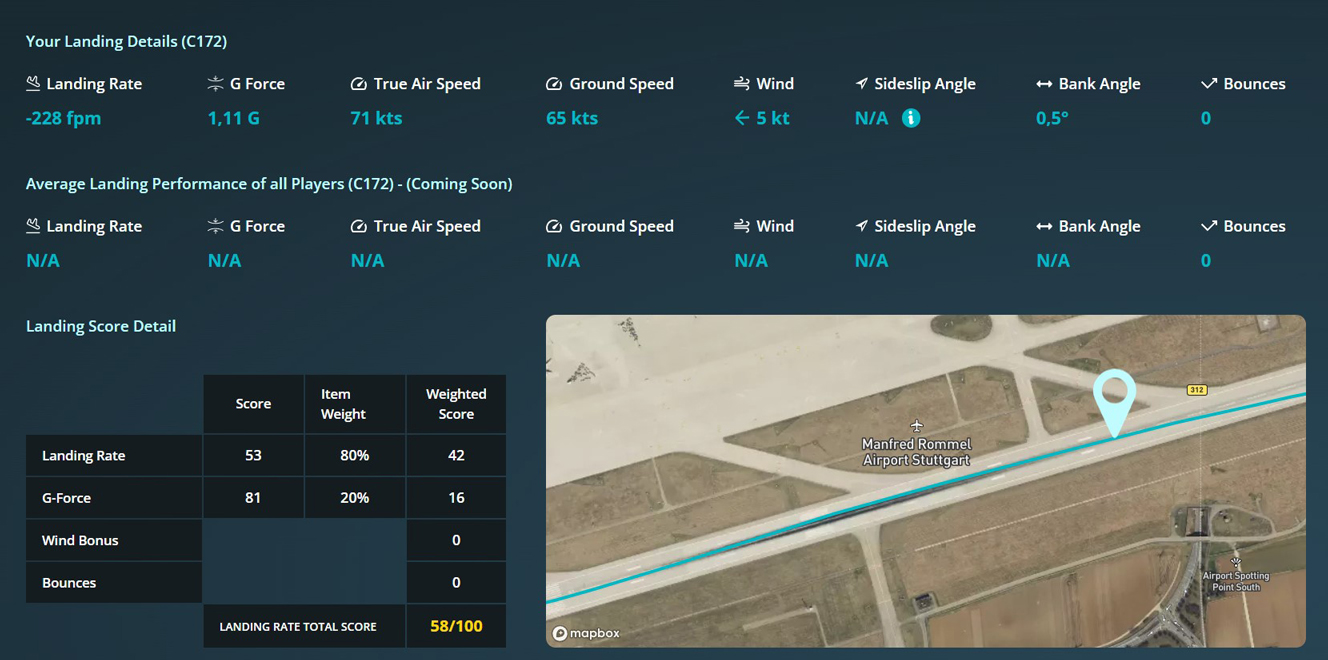This section of the manual will become active starting April 23, 2025
The Critical Phase of Landing in Flight Simulation #
Landing is one of the most critical phases of flight. SimFly’s sophisticated system provides a detailed analysis of this stage, empowering pilots to enhance their skills with tailored feedback for each airplane type. This is essential because each airplane exhibits unique flight characteristics, especially during landing.
Adaptive Analysis System for Diverse Airplanes #
SimFly’s analysis system is dynamically designed to adjust to various airplane models. This adaptation ensures that the feedback and scoring are specifically tuned to reflect the actual landing performance of each airplane, promoting accurate and relevant evaluations.
Scoring the Landing Rate #
The landing rate score ranges from 0 to 100, with higher scores indicating more precise landings.
A score of 66 marks a good landing and serves as a benchmark for skilled pilots, while higher scores signify exceptionally smooth landings.
Determining the Landing Score #
Several key factors influence the landing score:
– Landing Rate: Predominantly affects the score, accounting for 80% and considers the airplane’s weight
– G Force: Makes up 20% of the total score, reflecting the smoothness of the landing
– Weather Conditions: Weather challenges can lead to score bonuses, rewarding pilots for skillful handling under difficult conditions. Specifically, for those who choose to use real weather and encounter crosswinds, we offer bonus points to offset any potential landing penalties. This approach aims to ensure parity between those who prefer to fly with “Clear Skies” and those who choose to tackle real weather on a windy day
– Bounces: An important aspect to consider when evaluating the landing is the presence of bounces. Bounces occur when the aircraft touches down on the runway and then lifts off again due to excessive vertical speed or improper landing technique. Each bounce negatively impacts the landing score as it indicates a less controlled and less smooth landing.
Evaluation Criteria and Scoring Logic #
The Landing Rate Score rewards precision in landing, evaluating how close your descent rate is to the ideal value for the aircraft model you’re flying.
Each aircraft has its own optimal landing rate range, which depends on factors such as weight and other technical characteristics.
Example:
A Boeing 737 typically has an ideal landing rate between -100 and -180 FPM.
A Cessna 172 generally aims for a landing rate between -80 and -120 FPM.
The system automatically calculates the reference value based on the aircraft you’re using.
How the scoring works:
Landing too hard: If your landing rate exceeds the maximum acceptable limit for your aircraft, the score is zero.
Excellent landing: If your landing rate is close to the ideal value for the specific model, you can score up to 100 points.
Intermediate values:
Between the optimal value and the upper limit (slightly harder landing), the score increases progressively from 90 to 100.
If you go below the optimal value (harder landing), the score decreases following a curve that gradually penalizes excessively hard touchdowns.
Overly soft landings (touchdown rates close to zero) receive a decreasing score from 100 to 0, because an excessively soft landing is not always technically correct. A very low descent rate can be a sign that the aircraft is “floating” too long above the runway, potentially landing too far down and using more runway than necessary. This behavior can compromise operational safety or the realistic execution of the landing. Furthermore, especially in cases of wind or rain, a firmer touchdown is often safer, as it allows the aircraft to “anchor” itself more effectively to the runway and helps avoid risks such as aquaplaning or loss of control due to lack of immediate traction.
Note:
The system takes into account the specific characteristics of each aircraft. The goal is to reward precision and balance in your landing technique, adapting both to the type of aircraft and to weather conditions.

Future Enhancements #
SimFly plans to introduce a feature that monitors the precise contact point of the airplane with the runway. Once implemented, this will adjust the scoring weights: landing rate and contact point will each contribute 30%, with the existing factors remaining pivotal. This enhancement will refine the scoring system further, providing a more detailed assessment of a pilot’s landing proficiency.
Conclusion #
SimFly’s landing analysis system exemplifies the integration of advanced technology with practical flight training tools. By providing precise and adaptable feedback, it helps pilots of all levels improve their landing techniques in a variety of conditions and aircraft types. The upcoming enhancements promise to elevate this training tool, making it an indispensable asset for pilot training and development in the digital age.





